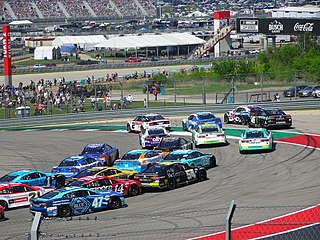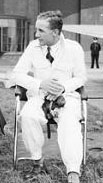Related Research Articles

Auto racing is a motorsport involving the racing of automobiles for competition.

The Coupe d'Aviation Maritime Jacques Schneider, also known as the Schneider Trophy, Schneider Prize or (incorrectly) the Schneider Cup is a trophy that was awarded annually to the winner of a race for seaplanes and flying boats. The Schneider Trophy is now held at the Science Museum, South Kensington, London.

Thoroughbred racing is a sport and industry involving the racing of Thoroughbred horses. It is governed by different national bodies. There are two forms of the sport – flat racing and jump racing, the latter known as National Hunt racing in the UK and steeplechasing in the US. Jump racing can be further divided into hurdling and steeplechasing.
Boat racing is a sport in which boats, or other types of watercraft, race on water. Boat racing powered by oars is recorded as having occurred in ancient Egypt, and it is likely that people have engaged in races involving boats and other water-borne craft for as long as such watercraft have existed.

Air racing is a type of motorsport that involves airplanes or other types of aircraft that compete over a fixed course, with the winner either returning the shortest time, the one to complete it with the most points, or to come closest to a previously estimated time.

Newmarket Racecourse is a British Thoroughbred horse racing venue in Newmarket, Suffolk, comprising two individual racecourses: the Rowley Mile and the July Course. Newmarket is often referred to as the headquarters of British horseracing and is home to the largest cluster of training yards in the country and many key horse racing organisations, including Tattersalls, the National Horseracing Museum and the National Stud. Newmarket hosts two of the country's five Classic Races – the 1,000 Guineas and 2,000 Guineas, and numerous other Group races. In total, it hosts 9 of British racing's 36 annual Group 1 races.

One-Design is a racing method which may be adopted in sports which use complex equipment, whereby all vehicles have identical or very similar designs or models, avoiding the need for a handicap system.

The term "air sports" covers a range of aerial activities, including air racing, aerobatics, aeromodelling, hang gliding, human-powered aircraft, parachuting, paragliding and skydiving.

Alexander Adolphus Dumphries Henshaw, was a British air racer in the 1930s and a test pilot for Vickers Armstrong during the Second World War.

Croft Circuit is a motor racing circuit located near Dalton-on-Tees in North Yorkshire, England. The tarmac circuit is 2.127 mi (3.423 km) long and is based on the lands of an airfield, but has long since moved on from being a basic airfield circuit. The circuit holds meetings of the British Touring Car Championship, British Rallycross and Pickup Truck Racing race series.

The Dragon is a one-design keelboat designed by Norwegian Johan Anker in 1929. In 1948 the Dragon became an Olympic Class, a status it retained until the Munich Olympics in 1972. The Dragon's long keel and elegant metre-boat lines remain unchanged, but today Dragons are constructed using the latest technology to make the boat durable and easy to maintain. GRP construction was introduced in 1973 and the rigging has been regularly updated.

Castle Combe Circuit is a motor racing circuit in Wiltshire, England, approximately 20 mi (32 km) from Bristol. The circuit is based on the perimeter track of a former World War II airfield, and was opened for racing in 1950.

Motorcycle racing is the motorcycle sport of racing motorcycles. Major varieties include motorcycle road racing and off-road racing, both either on circuits or open courses, and track racing. Other categories include hill climbs, drag racing and land speed record trials.

The King's Cup air race is a British handicapped cross-country event, which has taken place annually since 1922. It is run by the Royal Aero Club Records Racing and Rally Association.

His Majesty's Yacht Britannia was a gaff-rigged cutter built in 1893 for RYS Commodore Albert Edward, Prince of Wales. She served both himself and his son King George V with a long racing career.
Lympne Airport, was a military and later civil airfield, at Lympne, Kent, United Kingdom, which operated from 1916 to 1984. During the First World War RFC Lympne was originally an acceptance point for aircraft being delivered to, and returning from, France but was later designated as a First Class Landing Ground, RAF Lympne. It became a civil airfield in 1919 and saw the operation of early air mail services after the 1918 armistice. It was one of the first four airfields in the United Kingdom with customs facilities.

Captain Hubert Standford Broad, MBE, AFC (1897–1975) was a British First World War aviator and noted test pilot.
In the early 1980s the British Air Racing Championship was developed with the reformation of the Royal Aero Club Competition Committee into the Royal Aero Club Records Racing and Rally Association (3R), allocating points according to position in the field at the finish of each air race, accumulating throughout a racing season.
The Grosvenor Challenge Cup, commonly known as the Grosvenor Cup, was a trophy presented by Lord Edward Grosvenor in 1923 to the winner of a light aircraft time trial competition. Entries were initially restricted to British designs using aero engines of less than 150 horsepower. The first competitions were held at Lympne Aerodrome in Kent. The contest continued until 1935 with a break to 1949 when the Royal Aero Club resumed the races at Elmdon where the entry was opened to British and international designs with a weight less than 1,000 kilograms.

Winifred Sawley Brown was an English sportswoman, aviator and author. She was the first woman to win the King's Cup air race. The race has been running annually since 1922.
References
- ↑ "Championship Tables". Britishairracing.com. Retrieved 2013-06-13.